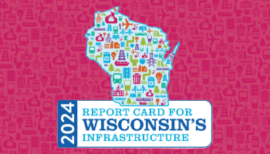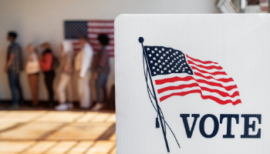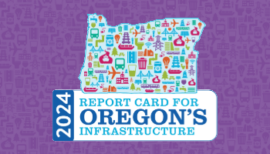Inland Waterways
Startup Uses Drone for Cleaning Water, Collecting Data

Mississippi’s infrastructure systems play a critical role in the state’s economic prosperity and help preserve – and can enhance – the quality of life for all Mississippians. However, over the past 15 years, our infrastructure systems have faced numerous, unprecedented challenges in the form of hurricanes, tornadoes, droughts, and floods. Yet, every time Mississippians are faced with a challenge, they rise to meet it. Our infrastructure systems have helped us meet these challenges; now it’s our time to help our infrastructure systems. To continue to raise, retain, and attract the best and brightest, Mississippi must invest in strategic infrastructure efforts.
After all, we want Mississippi to continue its long-standing tradition of hospitality, good Lord willing, even if the creek does rise. This is why local engineers with the Mississippi Section of the American Society of Civil Engineers (ASCE) have conducted an exhaustive evaluation of Mississippi’s infrastructure, based on publicly available data, reports, analyses, and conversations with state and local agencies. The 2020 Report Card for Mississippi’s Infrastructure was developed as a public service to citizens and policymakers to inform them of the infrastructure needs in 12 different categories in the state.
To view the Mississippi Report Card executive summary brochure, click here.
Mississippi’s aviation system is critical to the state’s economy; the industry employs over 20,000 people with a total payroll of $721 million and a total economic output of $2.5 billion. There are 73 public use airports in the National Plan of Integrated Airport Systems (NPIAS), 68 of which are non-primary and five are primary. Of the five primary airports, two – Jackson and Gulfport – have performed runway overlay projects over the last five years. Aviation infrastructure in Mississippi is heavily dependent on support from the federal government. The state experienced a 34% decline in passengers from 2007 to 2017, which impacts the amount of funding for aviation infrastructure the state receives from passengers and the federal government. As popular airports experience less demand, the life of the existing infrastructure is extended which leaves no significant operation and maintenance (O&M) needs unmet. However, O&M is not eligible for federal funding and, as a result, is deferred in more rural and low-income communities.
Mississippi has 17,072 bridges. More than 400 timber pile bridges have been closed to the public since 2018, when the federal government determined these structures had been insufficiently inspected and posed a risk to the traveling public. A total of 3,127 of Mississippi’s bridges are weight-restricted; some are posted for a four-ton load, approximately the average weight of a pick-up truck. To address safety concerns, the Mississippi Legislature convened a special session in August 2018 and voted to provide approximately $100 million annually for bridge maintenance and rehabilitation. While this additional funding is helpful, it does not come close to addressing the $1.6 billion funding gap for bridges in the state or reversing the years of underinvestment.
Mississippi’s dams provide flood control, navigation, water supply, recreation, and other benefits to the state’s population. The National Inventory of Dams (NID) records 6,081 known dams in Mississippi that are owned by a variety of federal, state, or municipal agencies, as well as private owners. 381 of these dams are high hazard potential, a classification not reflective of condition, but rather indicates that should the dam fail, loss of life and significant economic damage is expected. 130 of Mississippi’s high hazard potential dams need repair and more than 90% depend on the scarce financial resources of local governments or private owners. To best prepare downstream communities for possible failure, all high hazard potential dams should have emergency action plans (EAPs). However, in Mississippi, just 71% have EAPs on record. Also of concern is that 36% of state-owned dams are in poor or unsatisfactory condition. Approximately $1.21 billion dollars is needed to repair Mississippi’s non-federally owned dams.
Drinking water infrastructure in Mississippi includes water treatment plants, groundwater wells, storage tanks, and transmission lines that store and provide quality drinking water to consumers across the state. In 2015, the United States Environmental Protection Agency (EPA) estimated that Mississippi needs $4.8 billion over the next 20 years to fund safe drinking water infrastructure for the people of Mississippi. Much of the state’s current drinking water infrastructure is beyond or nearing the end of its design life, with older systems losing as much as 30-50% of their treated water to leaks and breaks. Adequate funding and prioritization of drinking water infrastructure improvements are needed to ensure Mississippians continue to enjoy quality drinking water for years to come.
Mississippi’s energy infrastructure, approximately 75% of which is privately owned and 25% of which is cooperatively owned, is closely related to the state’s economic development goals. The energy infrastructure portfolio includes nearly 14,000 miles of natural gas pipelines, four major gas storage facilities, 31 natural gas-fired power plants, and more than 4,000 miles of high and low voltage transmission lines. The pipelines have proven to be reliable with few long-term maintenance challenges. The transmission and distribution lines, however, experience periodic disruptions. On average, households experience more than 19 hours of electrical outages per year, most often the result of weather and falling trees. Potentially exacerbating reliability challenges: Mississippi’s electric cooperatives serve an average number of 8.1 consumers per mile of line, compared to the national average of 32 for investor-owned utilities and 41 for municipal-operated systems. This may increase vulnerability and result in longer outages when extreme weather related events occur throughout the state.
Mississippi has 870 miles of inland waterways, including the Tennessee Tombigbee Waterway, Yazoo River, Mississippi River, Pearl River, and the Gulf Intracoastal Waterway. The top two cargo passage lock and dams in the state, the John C. Stennis and the Whitten Lock and Dam, are located on the Tennessee-Tombigbee Waterway. Over the next 20 years, approximately $4.9 billion will be the needed investment for Mississippi inland waterways, or nearly $250 million annually. Adequate reinvestment and modernization of the state’s inland waterways is critical; nearly 2,000 vessels pass through the state’s locks every year, carrying over 4.3 million tons of domestic and foreign commodities, including coal, petroleum products, paper, concrete, steel, grain, and farm products.
Mississippi is home to over 900 miles of concrete and earthen levees that protect more than 300,000 people and $21.8 billion in property. Of the state’s 114 individual levee systems, 25 were constructed by U.S. Army Corps of Engineers (USACE) and are regularly inspected. Of these 25, 14 levee systems are rated unacceptable, meaning the condition of the system may prevent it from performing as intended or a serious deficiency has gone unaddressed. Little to no information is available about the conditions of non-USACE levees. The lack of publicly available information regarding Mississippi’s locally owned levees poses a challenge when assessing the overall condition, funding, and safety of levees in the state.
Mississippi’s ports are critical to the state’s economic wellbeing. A 2016 study conducted by the Mississippi Department of Transportation (MDOT) noted that Mississippi’s ports support over 125,700 jobs and nearly $5.4 billion in income while generating nearly $17 billion in economic stimulus annually. There are sixteen coastal and inland ports in Mississippi; the three largest are: the Port of Gulfport, the Port of Pascagoula, and Port Bienville. These ports serve as the United States’ ingress and egress points for millions of tons of goods every year. Two of these ports are considered deep-draft while the third is shallow-draft. The three largest Mississippi ports are investing in their infrastructure, but none are capable of receiving larger draft Post-Panamax ships. These ships are becoming increasingly common; if Mississippi wishes to capture the market they represent, public discussion must take place on increasing the dredging depths to accommodate larger vessels.
The railway system provides over a quarter of the freight services in Mississippi. Comprised of five Class I, one Class II, and 20 Class III rail lines, the network experiences a large amount of through freight traffic and provides travel options to a modest number of passengers. Privately-owned Class I railroads provide the most service, perform adequately, and are fit for the future. The Class II/III railroads are challenged with deteriorating tracks largely due to lack of funding, although limited dollars are available through several state programs. Priority for continued grade crossing improvements—including the addition of warning devices and resurfacing–should be a feature of future railroad capital programs. Throughout the state, about 65% of these grade crossings have no active warning devices and 10% have no warning devices at all. Fortunately, projects are continuously in progress to improve track awareness for public safety that will also provide more efficient rail operations.
Roadway projects in Mississippi are largely paid for with an 18.4 cents-per-gallon tax on gasoline, a rate that has not been raised for over 30 years. As a result, inflation and other factors have decreased the spending power of the state’s gas tax, leading to an inability to pay for necessary rehabilitation and maintenance projects around the state. In 2018, nearly 40% major urban road miles in the state were in poor condition, double the national rate, and 25% of the rural road network was also in poor condition. The average motorist spends $820 in extra vehicle repairs and operating costs because Mississippi roadways are in poor condition. Also of major concern: the state’s fatality rate in 2018 was one the highest in the nation, with 1.63 deaths per 100 million vehicle miles travelled, compared to 1.13 nationally. Raising the gas tax and indexing it to inflation would help close the annual gap of at least $400 million annually. Meanwhile, the state is developing innovative tools that increase the accuracy of roadway evaluation to improve the design of maintenance and rehabilitation projects, while also enhancing resource efficiency.
Mississippi generates over 6 million tons of municipal waste per year. There are 19 permitted landfills for non-hazardous industrial and municipal solid waste and 145 commercial rubbish disposal facilities. The average person in Mississippi generates 5 pounds of solid waste per day, which is above the national average of 4.4 pounds per person per day. Fortunately, Mississippi’s landfills have on average 55 years of remaining capacity left, although some individual facilities have less than 20 years and require more immediate expansion. The Mississippi Department of Environmental Quality (MDEQ) has seen a substantial downward trend in violations and fines over the past 20 years, an indication the state is trending in the right direction for protecting public health. One area of potential improvement lies in recycling. Just 5% of the waste generated in the state of Mississippi is diverted to recycling, compared with approximately 35% of municipal solid waste nationally.
While most wastewater treatment systems in Mississippi operate within their design capacity, over the past five years 1,180 failures were reported for onsite systems while 2,715 notices of violation were issued for wastewater treatment plants. Insufficient funds to cover routine operation and maintenance expenses result in backlogged upgrades that would improve treatment efficiency. While some utilities are raising rates to meet budget deficiencies, much of the state’s wastewater infrastructure is heavily dependent on federal funding; new approaches to closing the budget gap and financing wastewater improvements, particularly O&M and efficiency upgrades, should be considered. Overall, as the state’s population remains stable threats from increasing wet weather conditions, inconsistent maintenance, and a lack of rehabilitation pose extreme threats to the state’s wastewater infrastructure.
A: EXCEPTIONAL, B: GOOD, C: MEDIOCRE, D: POOR, F: FAILING
Each category was evaluated on the basis of capacity, condition, funding, future need, operation and maintenance, public safety, resilience, and innovation

Aviation
$3.7 million in 2022 airport improvement grants across 11 major airports

Drinking Water
$8.1 billion total drinking water need

Transit
2.1 million passenger trips across 24 systems in 2021

Bridges
16,788 bridges, 7% of which were structurally deficient in 2021

Hazardous Waste
14 Superfund sites

Wastewater
$2 billion total wastewater need

Dams
364 high hazard dams

Levees
1,019 miles of levees protect $21.8 billion of property.

Roads
54% of roads are in poor or fair condition
Smart investment will only be possible with strong leadership, decisive action, and a clear vision for our nation’s infrastructure.
If the United States is serious about achieving an infrastructure system fit for the future some specific steps must be taken, beginning with increased, long-term, consistent investment.
We must utilize new approaches, materials, and technologies to ensure our infrastructure can withstand or quickly recover from natural or man-made hazards.

Wisconsin’s infrastructure grade improves in 2024 Report Card
September 17, 2024
On September 17th, the Wisconsin Section of ASCE released the 2024 Report Card for Wisconsin’s Infrastructure at the state capitol building in Madison. The Report...

Infrastructure Is on the Ballot in 2024
August 23, 2024
Infrastructure Initiatives in Upcoming State Elections Labor Day weekend traditionally signals the end of summer and the start of a frenzied sprint to Election Day....

Oregon Infrastructure Report Card Receives a ‘C-’ in 2024
August 07, 2024
On Tuesday, August 6th, the Oregon section of the American Society of Civil Engineers (ASCE) released the 2024 Report Card for Oregon’s Infrastructure outside the...